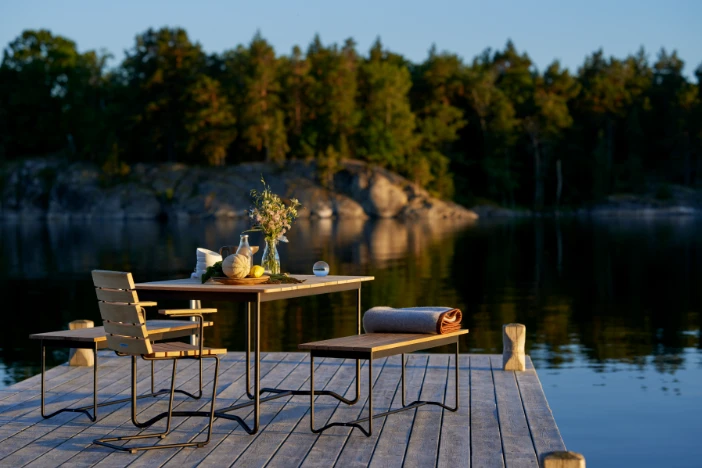
How to choose outdoor furniture that’s right for you
Living and entertaining used to take place primarily inside your home. Sure, you had to mow your lawn and maintain a modicum of landscaping for curb appeal, but it was more for aesthetics than anything else. Today, however, the growing in-outdoor lifestyle has migrated more activity outside and small homeowners can up the value of their property by enhancing outdoor spaces [Less, Birdson & Marion (1983)]. Furnishing areas beyond the four walls is more important than ever and choosing the right patio furniture can be difficult if you don’t know what to consider. Exterior design is similar to interior decorating, but there are additional factors that you should keep in mind. This guide provides the questions you should ask yourself when researching outdoor furniture.
Function & Usage – How do you plan to use your outdoor patio furniture?
Do you plan to host catered soirees and seat guests at a patio dining set with an expandable dining table and armchairs? Or do you just want to hang out with friends on a big comfy couch and lounge chairs with a coffee table for a casual drink, games and snacks? Perhaps you simply want to enjoy the sun on a leisurely warm Summer’s day on a chaise lounge with a cool drink by your side. Whatever the purpose, it’s a good idea to begin your planning with a list of what you want to do. Think about what pieces of furniture might be needed and how many people you want to accommodate.
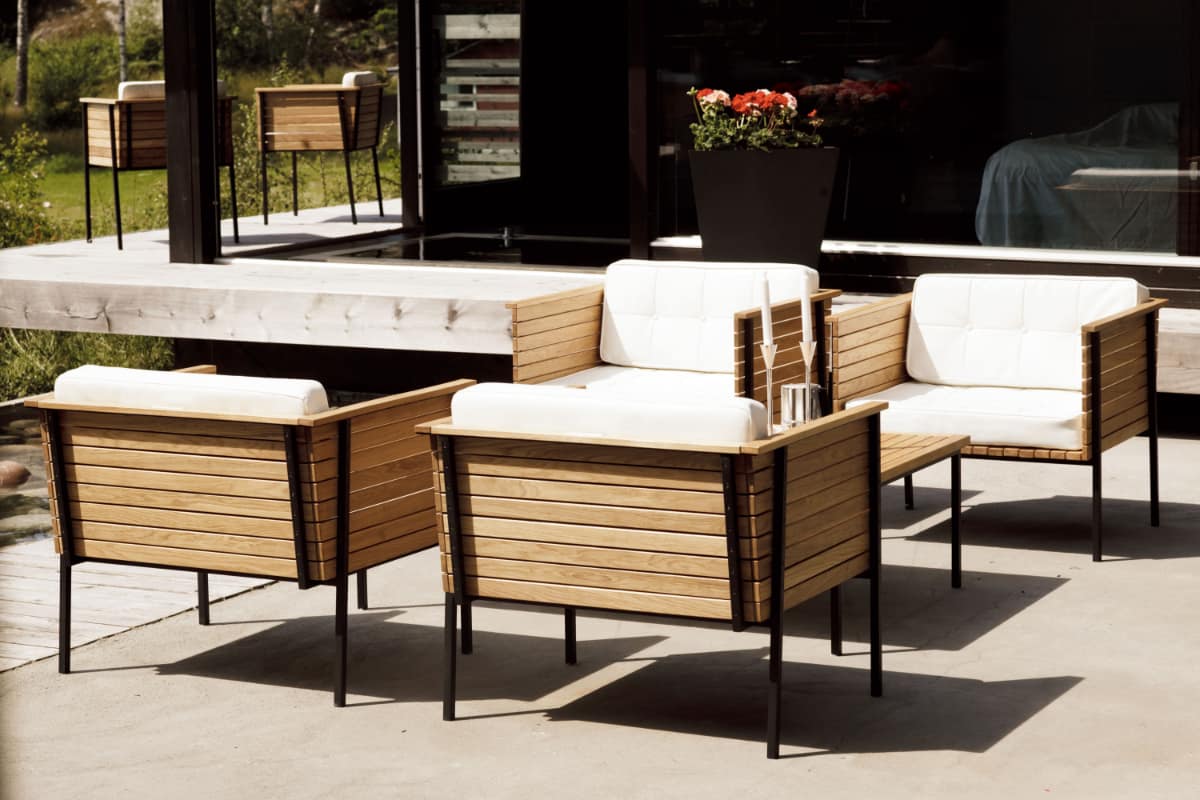
Location & Specs – What is your outdoor area like?
Type of space
You need to assess the space you’re planning to furnish. Are you outfitting a hardwood deck, patio, poolside, or a garden? Each of these outdoor areas has its own unique characteristics to consider when deciding on what outdoor furnishings to buy and what features are important. Uneven ground may require self-leveling table legs and swimming pools certainly need quick-drying cushions and fabrics.
Residential outdoor settings
Patio – Standard patios are great for outdoor dining, conversation sets or barbecuing.
Deck – Decks are stylish hardwood alternatives to concrete patios, but be careful with open flame fire pits.
Pool – Sunloungers, chaise lounges, daybed, side tables and umbrellas are must-have items poolside.
Porch – Laid back lounge seating is perfect for watching the sunset from a wrap-around or screened-in porch.
Garden – Decorative benches add a classic finishing touch to a well-manicured garden.

Commercial outdoor settings
Patio – Restaurants and bars utilize extra space in front and out back for alfresco dining.
Sidewalk – Cafes, bistros and coffee shops expand their seating to sidewalk areas, so customers can enjoy drinks and light fare outdoors.
Pool – Every hotel, resort and spa furnishes their poolside area with chaise loungers, lounge chairs, side tables and a variety of shade solutions. They may even have stools for guests of their outdoor bars.
Atrium – Open-air settings in the midst of buildings are often furnished with benches and small bistro tables and chairs for enjoying a coffee or light lunch.
Terrace – These upscale wide open spaces are ideal for kicking back on outdoor sofas and coffee tables at the end of the day in front of a scenic vista.
Balcony – Hotels typically provide a small dining table and chairs for guests to use for in-room meals.
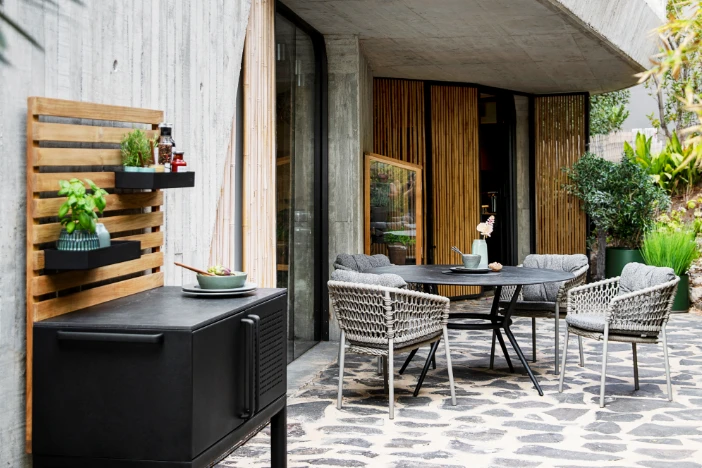
Surrounding Area
One of the first steps in landscape planning is to note the conditions and reality of the building and land area. Are there limitations that you have to account for or modify? Be cognizant of where the sun is positioned relative to everything, as well as the direction and strength of the wind [Buscher & Carpenter (1979)].
Is the space beneath an overhang, covered by a pergola or nestled among trees? A screened-in porch is virtually indoors, while a deck may be completely exposed or partially shaded by trees. Protection from harmful UV rays is critical if you spend a lot of time in the sun. Surrounding fences and hedges also impact the security, seclusion and feel of space. Are you looking to create a cozy nook or a more open laid-back area?
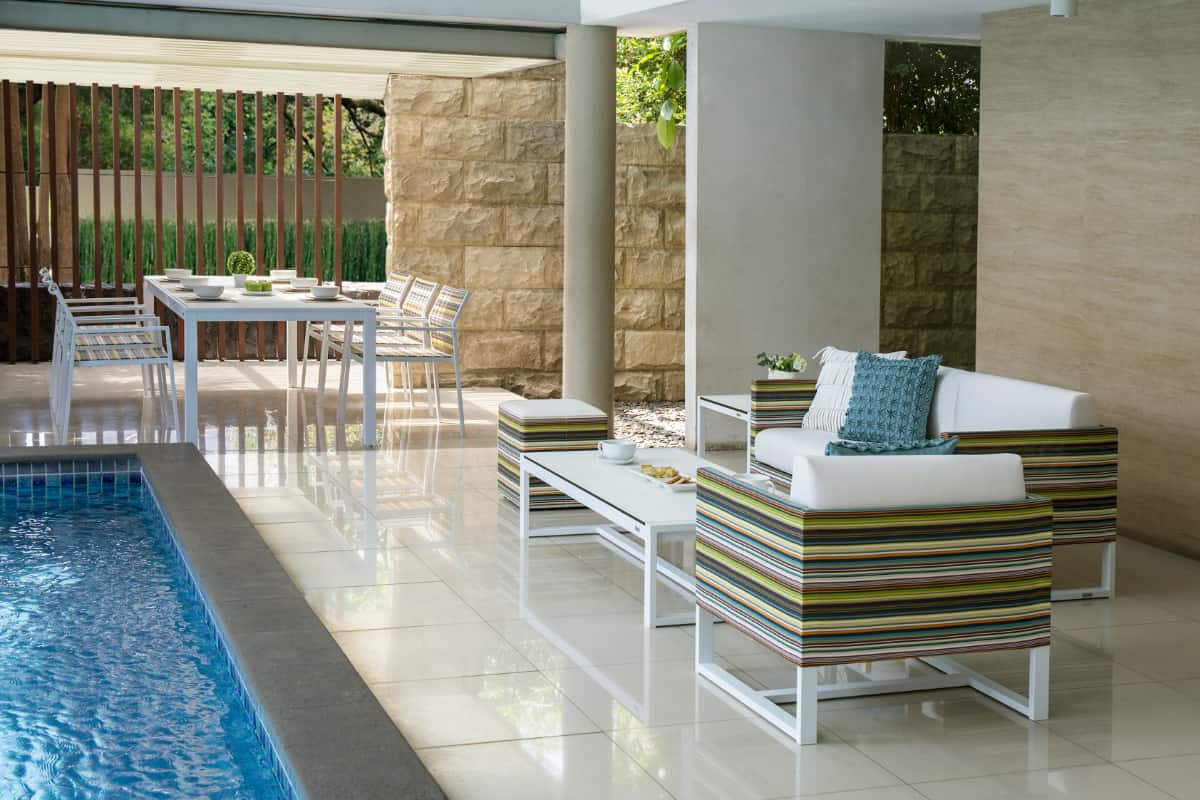
Dimensions & Flow
One of the most important things to do before purchasing outdoor furniture is to measure the space. You don’t want to order the sectional sofa of your dreams only to discover that it’s too big for your lanai after it’s delivered. Be sure to think about the usable space, shape and traffic flow, and not just the exact measurement from point A to point B. If you have an odd-shaped area, smaller pieces are a good option. A couple of bistro tables with barstools can accommodate the same number of people as a larger dining set.
Take a moment to think three-dimensionally too. You may have to use a little imagination to picture what it would be like to be seated in a particular spot. What would the eye-line be? How much room do you need to stand up and move about? Your space may be able to fit a bunch of pieces, but can you function normally without fear of bumping into something or someone? Dinner shouldn’t be a game of Twister.
Environmental Factors – What’s the weather where you live?
This is a critical factor that many people forget about until it’s too late. It may be a perfectly comfortable day when you decide to re-furnish your backyard, but what’s it like most of the Summer and during the off-season? How hot does it get? What about Winter? Is there a lot of direct sunlight? How much rain do you typically get each year? Do you experience high winds? Each of these impact the type of outdoor chairs and tables that are appropriate for your space. Make note of the conditions that your furniture needs to be able to handle.
Damp climates require furniture that is rust-resistant with weather-resistant upholstery and seat cushions. A wrought iron patio table may look amazing in perfect conditions but how much work do you have to put in with inclement weather to keep it that way? Similarly, powder-coated aluminum furnishings resist corrosion but may lightweight and at risk of blowing over in high winds. Know your environment and it’s needs.
Product questions to pose
At the end of the day, spending time outdoors should be enjoyable and stress-free. The furnishings that you surround yourself with should add to and not detract from the experience. Sure, there may be freak tornados or random raccoon migrations through your property, but for the most part, you know what to expect. Taking this knowledge and arming yourself with a little insight from this guide can help you choose the right kind of outdoor furniture for your home. The next section of our guide looks at different product attributes you should evaluate.
Guide Sections
Frequently Asked Questions – Buying Outdoor Patio Furniture
How do you choose deck furniture?
Choosing the right outdoor furniture is much more complicated than it used to be. Today’s emerging in-outdoor lifestyle gives you more factors to consider and questions to ask yourself.
- Function & Usage – Are you creating an area for lounging or al fresco dining? Do you plan to spend a lot of time outdoors or infrequently?
- Location & Specs – Are you furnishing a deck, patio, garden or poolside area? Does your architecture or landscaping affect what you need? How big is your outdoor space and what kind of traffic flow do you require?
- Environmental Factors – What’s the climate like where you live? Is it rainy, humid or near the ocean? How hot and dry does it get? Is it windy or does it get really cold in the Winter?
- Material Qualities – Which materials are best suited for this environment?
- Maintenance & Care – Are you willing to put in a lot of effort to maintain your patio furniture?
- Comfort Level – Do you prefer plush upholstered cushions, flexible slings or more rigid seating?
- Quality Considerations – Are you looking for expensive high-end quality that lasts years or are you okay with replacing low-cost outdoor furniture every other season?
- Personal Style – What design style suits your personality? Do you want your patio furniture to seamlessly blend with indoor decor or do you want a contrasting look and color palette outdoors?
- Flexibility & Ease – Is your space small? Do you want the ability to rearrange outdoor tables and chairs for a variety of purposes?
- Accessories & Accents – Do you need a patio umbrella or shade to block harmful UV rays? Would a fire pit provide needed warmth and ambiance? Is your outdoor space well-lit? What about rugs, pillows and other accents?
- Protective Measures – Do you need protective covers or storage space to ensure your patio furniture stays safe in bad weather or during the Winter?
What’s important to know when buying outdoor furniture online?
Buying outdoor furniture from an online retailer is distinctly different than purchasing it at your local store. There are a number of factors that you should be aware of when buying patio lounge and dining furniture from a website.
- Color & Texture – Images on a website are backlit by your computer or smartphone screen, so the colors you see are often brighter than the items are in person. The quality and closeness of the photography may also restrict your ability to discern the texture of frames, fabrics and tabletops. You must accept that there may be slight variances in the look and feel of the items.
- Comfort – Since online retailers typically don’t have a physical location, it’s difficult to determine how comfortable seating may be. You can get some idea by the dimensions and design specs, along with descriptions of the materials. However, you are rolling the dice a bit unless you have tested the particular chair or sofa in a showroom, someone else’s home or at a commercial property.
- Assembly – Some items may ship in pieces and require minor or major assembly. Make sure that web retailers provide adequate instructions and identify any tools needed.
- Shipping Costs & Service – Large patio furniture sets usually ship via a freight carrier on pallets. This can be very expensive if you ordered dining tables with glass tops, steel framed sofas or outdoor umbrellas with heavy bases. Most online retailers offer free curbside delivery, so be aware that you are responsible for getting everything to your backyard or patio. Some sites provide white glove services that will place your items, perform light assembly and remove packaging for an additional fee.
- Availability & Lead-time – Online-only retailers don’t have physical locations with finished products, so orders are dropshipped from manufacturers’ warehouses. Just because an item is shown on a website doesn’t mean it is currently in stock. Backorders or customized orders may need to be produced in Asia, Indonesia or Europe before shipping to U.S. warehouses. This lead-time can vary by brand, product, customization and manufacturing country. Expect restocking and custom orders to take between four and fourteen weeks.
- Return Policy – Manufacturers accept returns and replacements for defective items or orders damaged in transit. Many do not accept subjective returns (e.g. buyer remorse, slight variation in appearance, bigger than expected). If they do, there are always fees involved. Typically, you are on the hook for not only the cost to ship the return, but the initial shipping as well. Freight shipping is extremely expensive and can include residential delivery and liftgate fees on top of the simple shipping from point A to point B. A restocking fee is also usually imposed. Taken in total, these expenses can make up almost the entire cost of the order depending on the price point.
- Customer Service & Reviews – Some online retailers provide great customers service while others simply want to process your order. Don’t rush into placing an online order for expensive outdoor furnishings without checking out who you’re buying from first. Read their About Us section and customer reviews. See if they’re rated by the Better Business Bureau. More importantly, consider how they respond to your questions and requests for documentation and imagery. Are they prompt and complete in their replies, or do your email and voicemail messages disappear into the great void?
The lesson here is that you should take the time to do your homework before buying sight unseen from an online store. There is risk in investing in patio furniture without seeing and feeling it in person, but you usually get better prices than brick and mortar retailers and have more options in one virtual location.
When is the best time to buy patio furniture?
The word “best” is subjective depending on your objective and whether you’re buying outdoor furniture in person or ordering it from an online retailer.
- Lowest Prices – If you’re looking for a great deal from a brick and mortar outlet, your best bet is to look from August until October. These stores are trying clear out space for Fall inventory so they price patio collections to sell quickly. You won’t be able to use anything until next year, but you can save a bunch. Many online stores may offer discounts at this time too. However, since out of stock items and custom orders often take from four to fourteen weeks, many websites have early Spring sales so customers can receive their outdoor furniture in time for the current Summer season.
- Availability – If immediate gratification and risk avoidance is your thing, you should check out your local stores in March or April. That’s when they’ll likely start displaying their patio sets and you can get a sense of what they look like and how comfortable they are. Inventory levels start to grow at this time, so you don’t have to wait. Many online retailers have quick ship programs with plenty of stock of certain items in a specific color and finish options. If they’re in stock, you can usually get orders delivered within a couple of weeks. Like local stores, dropship warehouses are better stocked in the Spring than in the heat of Summer.
- Variety – If you want a broad set of options or a specific look, the earlier you start looking the better. Physical stores have their largest array of styles and colors early in the Spring, so it’s better to get a jump on things than risk having your favorite color gone or find that there are only five matching chairs for your outdoor dining table that seats eight. They may replenish stock, but probably not every SKU. Online stores usually offer more variety in styles, sizes, colors and accessories than their physical counterparts. But it often takes many weeks before you receive your customized patio set. So, you just need to determine when you want to be able to use your furniture and work backward to figure out when is the best time to order.
References
- Less, J., Birdsong, C., & Marion, M. (1983). Buying and remodeling a small home (Doctoral dissertation, Colorado State University. Libraries).
- Buscher, F., & Carpenter, J. D. (1979). Landscaping Around Home: Get Help, Plan Carefully. Department of Agriculture.

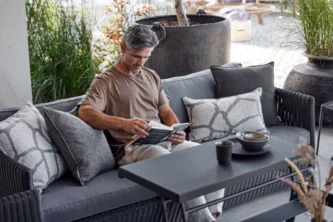
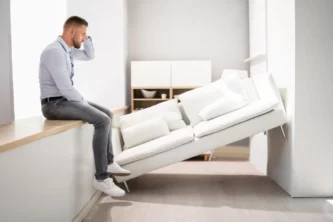






Thanks for this guide, it’s informative and very detailed and even included other accessories and finishing touches aside from the patio furniture. It’s given me a lot of ideas as to which pieces I should prioritize working around and investing in terms of quality and material choices. I’ve been looking at some options and I’m actually torn as to whether I should get a black or gray bench set with a center table, I guess I’ll try to play around with the colors while still maintaining a cohesive design for my patio.
The part of your article that discussed environmental factors as something to consider when getting outdoor furniture was definitely one I appreciated reading. This is something I think I should really take into account since the weather in the area rarely ever experiences rain, so furniture that can withstand the heat is necessary. I’ll ask an outdoor furniture store in the area for their recommendations for this kind of weather just so I can get the right pieces for it.
It was interesting to learn that the selection of furniture for a patio has evolved, in part, due to ergonomics. My wife and I plan to buy new chairs for our patio and possibly a fire pit, so we can entertain friends in the Summer. I also think it’s a good idea to find a furniture set that has a rustic look or something similar.
I like how you said that furnishing areas beyond the four walls is more important than ever and choosing the right patio furniture can be difficult. My parents just bought a huge house with a beautiful backyard and now they are concerned about how to decorate their house property. I will recommend them to search online for items that they would like to add in their outdoor decoration.
Wow! Thank you. This is the most comprehensive article I’ve ever read on furniture selection and I’m sure it will be helpful choosing the right pieces from your site. Your patio furniture is sensational.
Thanks Lola! If you do a little homework up front, it makes it easier to kick back and relax later.